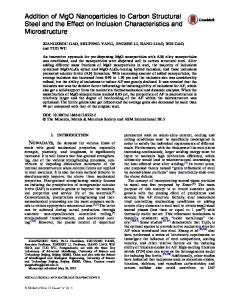Influence of copper on the structural characteristics of carbon nanofibers produced from the cobalt-catalyzed decomposit
- PDF / 383,150 Bytes
- 9 Pages / 612 x 792 pts (letter) Page_size
- 59 Downloads / 293 Views
MATERIALS RESEARCH
Welcome
Comments
Help
Influence of copper on the structural characteristics of carbon nanofibers produced from the cobalt-catalyzed decomposition of ethylene A. Chambers, N. M. Rodriguez, and R. T. K. Baker Catalytic Materials Center, Materials Research Laboratory, The Pennsylvania State University, University Park, Pennsylvania 16802-4800 (Received 12 June 1995; accepted 15 August 1995)
We have used a combination of techniques to examine modifications in the structural characteristics of carbon nanofibers produced from the interaction of cobalt and copper-cobalt powders with ethylene at temperatures over the range 425 to 700 ±C. The nanofibers generated from the interaction of cobalt with ethylene at 600 ±C were found to be highly crystalline in nature. Incorporation of as little as 2% copper into the cobalt created a major modification in the conformation of the solid carbon deposit, which was composed of multiple nanofiber limbs emanating from a single catalyst particle, and in this state the carbon structures tended to be disordered. As the composition of the bimetallic was progressively changed to the point where copper became the major component, there was a significant increase in the degree of crystalline perfection of the nanofibers even though they maintained their multidirectional form. The transformation in structural characteristics of the carbon nanofibers is rationalized, according to a concept wherein the crystalline order of the deposit is related to the wetting properties of the bimetallic particles with graphite.
I. INTRODUCTION
Catalytically produced carbon nanofibers have become an area of increasing attention in materials research. A recent comprehensive review of the subject has been compiled by Rodriguez,1 where not only the fundamental aspects surrounding the growth characteristics of nanofibers are covered, but also a discussion of possible applications of these structures is presented. Although it has been known for many years that the rate-determining step in the growth process of carbon nanofibers is the diffusion of carbon through the metal catalyst particle,2 it is only recently that it has been appreciated that the nature of the catalyst surface in contact with the reactant gas controls the first step in the process, the decomposition of the precursor molecule to produce carbon species.3 Furthermore, it is now evident that the interfacial properties that exist between the metal particle and the deposited carbon is a critical factor in determining the degree of crystalline perfection and geometric alignment of the graphite platelets constituting the nanofiber structure.4,5 While pure metals have frequently been selected as the catalytic entity, it is now being recognized that the presence of an adatom, either a metal or nonmetal, can induce major modifications to the nanofiber growth characteristics.6–10 These can take the form of perturbations to both the gas/metal and metal/solid carbon interfaces that can 430
http://journals.cambridge.org
J. Mater. Res.,
Data Loading...











